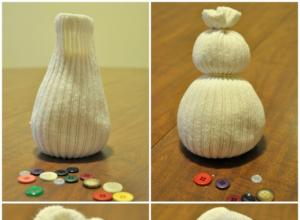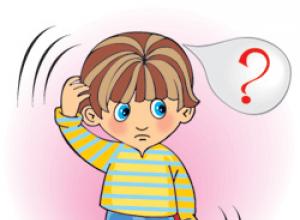Knitting pattern for a blouse for a newborn. Knitting for newborns - instructions for beginners
Made from super purified German Baby Wool yarn from Schachenmayr. If you still have about 125 grams of this yarn, then you can also knit this blouse for newborns. Together, the hat and blouse will make an excellent winter knitted set for newborns.
For a knitted blouse with buttons for newborns you will need
- Delicate woolen children's yarn Baby Wool from Schachenmayr (approx. 25 grams per skein at 85 meters). The total weight of yarn for knitting a blouse for newborns is 125 grams per child aged 1-2 months (150 grams per child aged 7-9 months; 175 grams per child 1-2 years old). If you use Baby Wool yarn from Schachenmayr, from which we knitted, then take natural tone No. 00002.
- Regular knitting needles with a diameter of 2.5 mm or 3.5 mm (choose those knitting needles that are most suitable for achieving the knitting density indicated below).
- 4 white buttons (or any other color to match the yarn used). The approximate diameter of the buttons is 8 mm.
Size knitted blouse for a newborn: 62-68 (74-80; 86-92) - these numbers correspond to the child’s height in centimeters. The first numbers before the brackets indicate the child’s age 1-2 months, then the first numbers in brackets indicate the child’s age 7-9 months, the last numbers in brackets indicate the child’s age 1-2 years.
Patterns for knitting a blouse with buttons for a newborn
Double elastic band, used in this model as a “relief stripes” pattern: we knit, alternating, 2 front loops and 2 purl loops.
Knitting “braids”: in front or odd rows we knit the pattern according to the pattern, in purl or even rows we knit loops according to the pattern, that is, the way they lie.
When making the back of a knitted blouse with buttons for newborns, the left front and sleeves of a knitted blouse for newborns, we begin knitting in the 1st row after the edge loop, as shown in the diagram, constantly repeating the repeat of 7 loops, knitting the remaining loops and edge stitches accordingly.
Knitting density of blouses for newborns
We knit 32 loops on 38 rows with “braids” and measure the given sample, which should be 10 cm long and the same number of centimeters in height.
Description of knitting blouses for newborns
Knitting the back of a knitted blouse for newborns:
cast on 79 loops (86 loops; 100 loops) and knit with a “braid” pattern, while knitting the first row on the front side. Having knitted 10 cm (12 cm; 14 cm), which is equal to 38 rows (46 rows; 54 rows) from the beginning of work, bind off 2 loops from each edge to form armholes, then in each 2nd row 5 times 1 loop. Thus we get 65 loops (72 loops; 86 loops). Having knitted 20 cm (23 cm; 26 cm), which is equal to 76 rows (88 rows; 100 rows) from the beginning of work, close off 6 loops (8 loops; 10 loops) to form a shoulder bevel and in every 2nd row 2 times 7 loops (7 loops; 9 loops). At the same time, when performing the last decrease, we close the remaining 25 loops (28 loops; 30 loops) for the neckline. The total length of the back of a knitted blouse for a newborn should be 21 cm (24 cm; 27 cm).
Knitting the left front of a knitted blouse for newborns:
cast on 20 loops (24 loops; 31 loops) and knit with a braid pattern. At the same time, to complete the rounding, we again cast on the left edge at the end of the 1st front row 1 time 6 loops, then in each 2nd row 1 time 4 loops and 2 times 2 loops, knit a “braid”, then knit 4 times in each 2nd row and 1 time in every 4th row along the left edge in front of the edge loop in accordance with the pattern: 1 knit loop or 1 purl loop crossed from a transverse thread. As a result, we get 39 loops (43 loops; 50 loops). The “braid” ends on the left edge with 4 knit loops and an edge loop for sizes 62/68 (1 knit loop and an edge loop for sizes 74-80 and 86-92).
Having knitted 10 cm (12 cm; 14 cm), that is, 38 rows (46 rows; 54 rows) from the beginning of work, close 7 loops, as on the back. In order to knit the recess under the armhole there must be 32 loops (36 loops; 43 loops) on the knitting needles. At a height of 16 cm (19 cm; 22 cm), that is, at a height of 60 rows (72 rows; 84 rows) from the beginning of work, close 6 loops (7 loops; 8 loops) along the left edge for cutting the neckline and then in each 2- m row 1 time 2 loops and 4 times 1 loop (5 times 1 loop; 5 times 1 loop).
When there are 20 cm (23 cm; 26 cm), that is, 76 rows (88 rows; 100 rows) from the beginning of knitting the left front of a knitted blouse for newborns, close 20 loops (22 loops; 28 loops) along the right edge to form a shoulder bevel. like on the back. The length of the left front of a knitted blouse for a newborn should be 21 cm (24 cm; 27 cm).
Knitting the right front of a knitted blouse for newborns:
we knit similarly to the left front, but maintaining symmetry with regard to making the recesses for the armhole and neckline. We start knitting the “braid” in the 1st row with 2 purl loops after the edge loop - this is for size 62/68, with 3 knit loops after the edge loop - this is for sizes 74/80 and 86/92. To perform a rounding along the right edge, we again cast on the loops at the end of the purl row or before the edge loop from the transverse thread.
Knitting the sleeves of a knitted blouse for newborns:
cast on 42 loops (42 loops; 50 loops), knit 2 cm with a double elastic band, that is, with a “relief stripes” pattern; We start from the purl row and in the last purl row we evenly add 9 loops (9 loops; 8 loops). Thus, after increasing, you should get 51 loops (51 loops; 58 loops). Next we knit “oblique”. At the same time, to form an extension of the sleeve, in the 3rd row from the elastic band, add 1 loop on both sides 1 time, then 9 times, 1 loop in each 4th row - this is for size 62/68 (10 times, 1 loop in each 4 - row and 2 times 1 loop in every 2nd row - this is for size 74/80; 4 times 1 loop in every 6th row and 8 times 1 loop in every 4th row for size 86/ 92). There should be a total of 71 stitches (77 stitches; 84 stitches).
Having knitted 11 cm (14 cm; 17 cm), that is, 42 rows (52 rows; 64 rows) from the elastic band, we close 2 loops from each edge to obtain a sleeve roll, then in each 2nd row 5 times 1 loop, 2 times 2 loops, 2 times 4 loops and the remaining 33 loops (39 loops; 46 loops). The length of the knitted sleeve of a knitted blouse for newborns should be 18 cm (21 cm; 24 cm).
We knit the second sleeve using the same principle.
Sewing knitted parts of a knitted blouse for newborns
We make seams on the sides of the blouse, seams on the sleeves and sew the sleeves into the armholes.
In order to knit the strips of the shelves and the lower strip of the back, we cast on circular knitting needles 30 loops (41 loops; 48 loops) along the straight section of the edge of the left shelf, 18 loops along the curve of the shelf, 18 loops (21 loops; 29 loops) along the section to the side seam - in total you should get 66 loops (80 loops; 95 loops), then cast on 72 loops (80 loops; 94 loops) along the cast-on edge of the back, 66 loops (80 loops; 95 loops) along the edges of the right shelf = 204 loops in total ( 240 loops; 284 loops). We knit these cast-on loops with “relief stripes”, that is, with a double elastic band, starting the 1st row on the wrong side with 2 purl loops after the edge loop. In the 2nd row, we make 3 holes for buttons on the left shelf bar. To do this, starting from the edge of the neckline, knit an edge loop and 6 loops (10 loops; 12 loops), 2 loops together with the “relief stripes” pattern, 1 yarn over, make a rapport starting from the star, like this: *8 loops (12 loops ; 14 loops), 2 loops with the “relief stripes” pattern, 1 yarn over – repeat this group of loops 1 more time, knit the remaining loops according to the pattern. In the next row we knit yarn overs with a “relief stripes” pattern. We knit 5 rows and bind off all loops.
To knit the neck trim, we cast on 72 loops (76 loops; 80 loops) on circular knitting needles along the entire neckline, including the edges of the straps, and knit with a “relief stripes” pattern, starting on the wrong side with 2 purl loops after the edge loop B 3- On the 4th row we knit an edge loop and 2 knit stitches for the 4th button hole, make 1 yarn over, knit the next 2 purl loops together, in the next row we knit a yarn over with knit stitches. We knit 5 rows for the binding and close off all the loops. Sew on the buttons.
If the expectant mother is a craftswoman and needlewoman, then without further ado you can predict what she will do before the birth of the child. After all, even a knitted blouse for a newborn or a romper is an opportunity for a woman to take care of her baby and prepare for his arrival in advance.
Children's things knitted by mother's hands seem much cozier, more convenient, and more beautiful. And for good reason, since the mother not only puts effort into the knitting process, but also takes a direct part in choosing the yarn, pattern and model of the future product. This activity will also be useful and enjoyable for beginning needlewomen who are preparing to become mothers.
Choosing yarn for delicate baby skin
The main factor that you should rely on when purchasing is the softness of the threads. Baby's skin is too sensitive for harsh fabrics or knitted items.
1. Acrylic and cotton yarn are most preferred.
Many people believe that acrylic is harmful to babies because it is synthetic.
Whether it’s knitted blouses for newborns or crocheted rompers, the store will advise you on special acrylic yarn for children. Its peculiarity is the hypoallergenicity and tenderness of the fibers.
2. Everything is clear about natural threads - they do not cause irritation and allow the child’s skin to breathe.
Trying to knit a blouse for a newborn using raglan

Regular raglan is a special type of cut. In this case, the sleeve is cut out together with the shelf, that is, the front shoulder part and the back. The diagram and description of the steps below will explain how a regular knitted blouse for newborns will become original if you add raglan to the product. This product is suitable for babies up to 3 months old.
Calculation of loops for knitting
Please note that the average neck circumference of a baby who is not even 3 months old is 22 centimeters. In this case, the knitting density will be 2.5 loops per 1 centimeter. The required width of the strip is about 2 centimeters. Therefore, the circumference of the neck of the product will be 20 centimeters. Using approximate measurements, calculate the approximate number of loops. So, you will get about 50 loops.

And now Raglan. Subtract from the total number the number of stitches sufficient for 1 line of raglan. Multiply the resulting figure by 4. There should be 38 loops left, which should be divided into several equal parts. Don't forget to add the resulting remainder to the average of them. Thus, you have 2 shelves of 14 loops, 2 sleeves of 12 each and a back of 12 loops. It turns out that both the right and left sleeves have 6 loops. From this number, subtract 1.5 centimeters and add to the front.
As a result, there will be 12 loops on the back, 10 on the fronts, and 3 loops on the sleeves. Now the knitted blouse for a newborn will turn out perfect, because you have completed the main and important step - calculated the correct number of loops and chose a model, adding raglan to it. His line will consist of 3 front ones. Remember that on both sides of it, on every 2nd row, it will be necessary to make increases in order to expand the fabric. For knitting them, a pattern called stitches is recommended.
Beginning of work
You will need:
- about 200 grams of light green yarn of excellent quality;
- at least 50 grams of white yarn;
— knitting needles numbered 3 and 4;
- five small buttons.
Knitting a blouse for newborns with knitting needles begins with casting on the first 50 loops. Next, knit them over 3 rows in one stockinette stitch. Switch to knitting with green threads. Purl row 1. If everything is done correctly, the loops will be distributed like this: 10 on the right front, raglan of 3 loops, the same number on the right sleeve, raglan of 3, 12 on the back, again 3 loops on the raglan, 3 on the left sleeve, raglan again, and 10 loops of the right shelf.
To make work easier, place stationery pins or special markers on the lines, as well as through every 3 connected loops of the shelves.
Start knitting. The first row begins with 10 loops of the right front, then 1 yarn over, raglan of 3, 1 yarn over, 3 right sleeve loops, 1 yarn over, again 3 sleeve loops, again yarn over, followed by 12 back loops and yarn over. After this, the knitting can be turned over. Next, knit another 16 rows, following the pattern.
Gradually, the knitted blouse for newborns takes on familiar shapes. At this stage, all tools are working. Continue working, adding the main loops along the raglan of the product until it reaches 12 centimeters along the shelves. By this time, there should be 194 stitches left on the knitting needles.
Closing and opening the right and left shelves
At the next stage, you will be closing both the right and left shelves. All that is needed for this is a regular auxiliary thread. After this, you can start working on knitting the sleeves of the product. It is to them that you need to attach 2 loops, focusing along the raglan line. Are there any loops left? No problem. They need to be connected with connected shelves and a small back.

The line reached the sleeves. At this stage, the size of each of them is about 19 centimeters. Knit 8 rows, then in the next 4 rows make a single decrease from the edges of the sleeve. It's time to introduce white baby yarn. Using comfortable size 3 needles, start knitting the cuffs. After this, you can close off all unnecessary loops. If you measure from the neckline, the sleeve length will be 33 centimeters.
Proceed with the almost completed shelves and back. First, you need to remove the used auxiliary thread from these parts. Transfer them and combine them into a whole knitted fabric. To do this, knit edge stitches at common seams. Now you can continue with stockinette stitch. Thus, knit 19 centimeters of fabric. Then, by yarn over every 9, add 11 stitches.
Switch back to knitting elastic using white and green threads. Do the elastic in the same way as you did on the sleeves. Remove unnecessary loops again.
Placket and neck design
Take care of the strap and neck design. To do this, cast on 100 loops along the edges of the shelves. Work over the placket with a regular rib using green and white baby yarn. Don't forget to make several holes on the right placket for buttons. Now the unnecessary auxiliary thread can be torn off from the neck.
Knit several rows with a rib pattern. After 5 rows, make a hole for the button above the right placket.
The most pleasant moment comes, namely the assembly of parts. Using a vertical knit stitch, sew the sleeves together and place the buttons.
A simple and very beautiful blouse for a newborn, knitted with a round yoke
Knitted blouse for a newborn
A blouse for a newborn is knitted from the neck down, with stockinette stitch and a relief pattern with constrictions.
Carole Barenys
Size: 3 (6) months
Materials: Bernat Softee Baby yarn (100% acrylic, 140 g/331 m), circular and double needles 3.5 mm, 2 additional knitting needles or stitch holders, button markers.
Knitted blouse for a newborn, job description:
Yoke: cast on 60 stitches.
Rows 1-2: knit stitches.
Row 3 for boys (right side, button hole): k2, yarn over, k2tog, finish with knit stitches.
Row 3 for girls (right side, button hole): knit to last 4 stitches, k2.
Repeat button hole every 10 (12) rows.
Rows 4-5: knit stitches.
6th row (wrong side): knit 4, knit purl to last. 4 loops, 4 knits.
7th row: facial loops.
8th row: k4, knit purl to last. 4 loops, 4 knits.
Row 9: K4, *knit the loop twice, k2, repeat from *, finish k4. = 78 loops.
Row 10 (wrong side): knit 6, slip 2 stitches as purls, yarn behind work, *knit 2, slip 2 loops as purls, yarn behind work, repeat from *, complete knit 6.
11th row: facial loops.
12th row: knit as 10th row.
13th row: k4, *knit a loop twice, k3, repeat from *, finish k5. = 96 loops.
14th row: k4, knit purl to last. 4 loops, 4 knits.
15th row: facial loops.
16th row: k4, knit purl to last. 4 loops, 4 knits.
Row 17: K5, *knit a loop twice, k4, repeat from *, finish k5. = 114 loops.
Row 18 (wrong side): knit 6, slip 2 stitches as purls, yarn behind work, *knit 2, slip 2 loops as purls, yarn behind work, repeat from *, complete knit 6.
19th row: facial loops.
20th row: knit as 18th row.
Row 21: K6, *knit a loop twice, k5, repeat from *, finish k5. = 132 loops.
22nd row: k4, knit purl to last. 4 loops, 4 knits.
23rd row: knit with knit stitches, make a hole for a button for a smaller size.
24th row: knit 4, knit purl to last. 4 loops, 4 knits.
Row 25: *knit 6, knit a loop twice, repeat from *, finish knit 6. = 150 loops.
Row 26 (wrong side): knit 6, slip 2 stitches as purls, yarn behind work, *knit 2, slip 2 loops as purls, yarn behind work, repeat from *, complete knit 6.
27th row: knit with knit stitches, make a hole for a button for a large size.
28th row: knit as 26th row.
Row 29 for smaller size: knit stitches.
Row 29 for large size: *K7, knit a loop twice, repeat from *, finish k6.
Knit in stockinette stitch + garter pattern on the slats for another 2 (6) rows.
Track. row (wrong side): knit 4 knits, 22 (26) purl, put a marker (front), 26 (27) purl, put a marker (first sleeve), 46 (54) purl, put a marker (back ), 26 (27) purl., put a marker (second sleeve), 22 (26) purl., k4. (shelf) = 150 (168) loops.
Track. row (increment): *knit up to 2 stitches before marker, knit stitch twice, knit 1, marker, knit stitch twice, repeat from * - 8 stitches added in row.
Track. Row: 4 knits, knit purl to last. 4 loops, 4 knits.
Repeat last two rows 4 (5) times = 190 (216) stitches.
Don't forget about the next button hole!
Back and shelves:
Track. row: *knit to last 2 stitches before marker, add stitch, k1, slip marker, cast on 4 stitches for armhole, skip sleeve stitches to next marker, repeat from * for back stitches, finish with knit = 130 (150) stitches shelves and back.
Continue knitting in stockinette stitch + garter pattern for front panels to the desired length of the blouse.
For girls, you can make another strip of the pattern as in rows 10 and 11.
Sleeves: remove sleeve loops onto stocking needles, pick up 4 armhole loops.
Knit in the round in stockinette stitch – 3.5 cm.
Decrease on the next row until there are 36 stitches left on the needles.
For girls only:
Track. row: persons. loops.
Track. Row: *P2, slip 2 stitches, thread before work, repeat from *.
Track. 3 rows: faces. loops.
Boys only: knit 4 rows with knit stitches.
For everyone: decrease 4 stitches along the next line. round row = 32 loops.
*Knit 1 row with purl stitches.
Knit 1 row with knit stitches, repeat from * 2 times.
close the loops.
Hide the ends.
Sew buttons.
I suggest you knit a suit for a newborn (or for an unborn baby). Costume consists of a blouse and pants.
If you knit a suit from threads with the addition of wool, you can use it for walks or going to the clinic.
A suit made from acrylic threads will be less warm and can be worn at home (for example, when the heating is turned off and the apartment is cold).
The advantages of the jacket are the buttons: it will be convenient for a small child to put it on and take off.
We knit a blouse for a newborn
We will knit a blouse for a newborn on knitting needles, so we will need:
- knitting needles No. 3.5;
- yarn (I used 50% wool, 50% acrylic yarn, I needed a little less than 2 skeins of 100 grams each);
- 4-5 buttons.
Sizes: in the photo the jacket and pants are approximately size 56/62. Anyutka wore them until about 3-4 months (she was born 54 cm). But you can knit a larger suit, then it will last longer. In the knitting description in brackets I will indicate the number of loops for size 56/62, and in brackets for size 68/74.
Knitting the back
Cast on 54 (62) loops on the knitting needles and tie 3 cm with an elastic band (elastic band 2*2: 2 knit loops and 2 purl loops).
Remember that the first and last loops are edge stitches (i.e. you remove the first loop, then knit an elastic band, purl the last loop).
At the same time, from the side of the cutout, gradually close the loops according to the scheme:
- knit a row;
- in the next row cast off 3 stitches;
- in the next row cast off 2 stitches.
After 25 (29) cm from the elastic band, bind off the remaining shoulder loops.
————————————————————————————
Knitting pattern for the main pattern.
The pattern is knitted according to the pattern shown in the figure.

The figure shows 1 rapport. Repeat repeat loops in width, in height - from rows 1 to 8.
—————————————————————————————-
We knit the right front
Cast on 26 (30) loops and tie 3 cm with an elastic band.
After 20 (24) cm from the elastic band, close 5 (6) loops for the neckline from the right edge, and then gradually close the loops according to the scheme:
- knit a row;
- in the next row cast off 2 stitches;
- knit another row without closure;
- knit another row without closure;
- in the next row cast off 1 stitch;
- knit another row without closure;
- In the next row cast off 1 stitch.
Those. in every second row we close 2 loops once, and 1 loop three times.
At the height of the back, bind off the remaining shoulder loops.
The left front is knitted symmetrically to the right.
Knitting sleeves
Cast on 42 loops and tie 3 cm with an elastic band.
For side bevels, add on both sides:
- for size 56/62: in every 2nd row 2 times 1 loop;
- for size 68/74: in each 6th row 7 times, 1 loop.
including added loops into the pattern. After 11 (14) cm from the elastic, close all the loops.
Assembling a blouse for a newborn
- Sew shoulder seams.
- Along the edges of the jacket fronts, cast on 56 (64) loops and tie the fastener strips.
To make the strip more dense, it is knitted double.
For this:
From the front side, cast on the loops on the knitting needle (from 4 rows, cast on 3 loops) and knit 3 rows with the front stitch. Set aside the loops.
Is there a new addition to your family or your friends’ family? Do you dream of knitting something for your newborn baby? Then you came to our site not by accident. Knitting for newborns: knitted socks, knitted overalls for newborns, baby knitted hat, sets for newborns, knitted booties, knitted hats, dresses, panties, blouses. All models are on the website with free detailed descriptions, photographs, diagrams, patterns and knitting recommendations. In the first years of a baby’s life, it is very important that the baby is warmly dressed and every mother wants everyone to admire him. Be sure to knit some cute little thing for your newborn baby or ask your friends! The models on the site will satisfy every taste. Free crochet and knitting patterns and patterns for newborns.

Size: for ages 3 to 6 months
To knit booties of a smaller (or larger) size, you need to take a smaller (or larger) hook number and yarn of the appropriate thickness.

Yarn for knitting white overalls for newborns “Ecolana Boucle”.
Color number: 01 (cream) number of skeins: 6 “Ecolana” yarn
Color number: 01 (cream) number of skeins: 1 knitting needles: No. 4

You will need
500g of yarn Fnldar “Sport Laine” (51% wool, 49% polyacrylic. 76m by 50g) light blue (color No. 16): knitting needles No. 4,5 and No. 5; “house” and “bunnies” appliqués, 6 buttons. Or: 500g of “Sweet” yarn from Ilsewolle (70% polyacrylic and 30% wool, 280m by 50g) blue (color No. 4728), knitting needles No. 4,5 and No. 5.
Knitting patterns:
Persons smooth surface: faces. and out. R. knit faces P.
Garter stitch: knit. and out. R. knit faces P.

Knitted baby envelope with hood
Latest site materials
Experience

Simple New Year's crafts with children: inspiring ideas and master classes
15 New Year's crafts you can do with your kids! There is very little time left until the New Year, and it’s time to think about holiday decorations for the home. You can buy ready-made options in the store, but it’s much better to make your own original things
Cooking

Summer hair protection products
During the hot season, many people use sunscreen; they reliably protect the skin from the negative and harmful effects of bright ultraviolet rays. But for some reason, almost all of us forget that hair also needs additional
Experience

Problems with fathers and children, or what to do if the father does not love
Psychologists constantly note that psychological trauma received in childhood becomes fertile ground for the emergence of complexes.
Experience

Sometimes a person cannot get rid of them on his own, because seeing the connection between one and the other is sometimes not easy. One
Fashionable manicure for short nails with video and photos
Horoscope

It would seem that just recently our women’s world was overwhelmed by the fashion for long, sharp or square nails. However, time moves, fashion changes, and now at the peak of popularity is a completely opposite option - short nail length. In this article we will
According to the eastern horoscope, the “master” of the New Year 2017 will be the Fire Rooster. The wild temperament, cocky character and truly fiery temperament of this fighting bird will accompany us next year. And in order to “appease” the bird and get it
